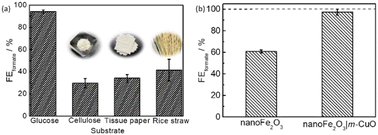Selective production of formate over a CuO electrocatalyst by electrochemical and photoelectrochemical biomass valorisation†
Abstract
Electrochemical and photoelectrochemical valorisation of biomass is an attractive technology to provide value-added chemicals such as formate in a sustainable way. Monoclinic CuO acting as an efficient non-precious electrocatalyst for formate production from glucose and cellulose is reported. Notably, a high faradaic efficiency of 94.1 ± 1.5% and a turnover frequency of 240.2 ± 16.3 h−1 for formate production at an applied potential of 1.5 V vs. reversible hydrogen electrode (RHE) are achieved using monoclinic CuO as the electrocatalyst for glucose oxidation. The mechanism of formate generation from electrocatalytic oxidation of glucose is elucidated by product analyses and electron paramagnetic resonance (EPR) study. The results suggest that one glucose is oxidised to one formate and one pentose mediated by the generation of OH radicals during the electrolysis. Electrocatalytic formate production using purified α-cellulose and “real world” biomass wastes was also investigated. In particular, a moderate faradaic efficiency of 41.4 ± 9.7% was observed using rice straw as the substrate. Furthermore, monoclinic CuO acts as an efficient cocatalyst on a hematite photoanode, showing a faradaic efficiency of 97.3 ± 2.8% for formate production through photoelectrochemical glucose valorisation.

- This article is part of the themed collection: Emerging Investigator Series


 Please wait while we load your content...
Please wait while we load your content...